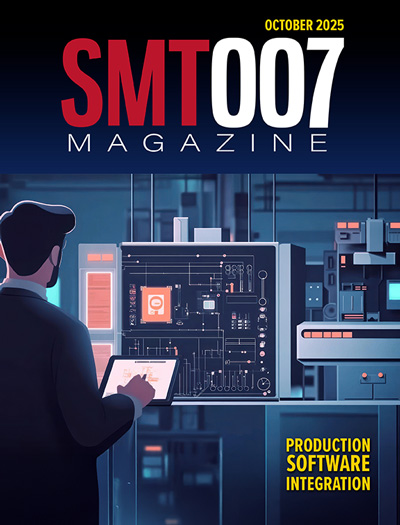-

- News
- Books
Featured Books
- smt007 Magazine
Latest Issues
Current Issue
Production Software Integration
EMS companies need advanced software systems to thrive and compete. But these systems require significant effort to integrate and deploy. What is the reality, and how can we make it easier for everyone?

Spotlight on India
We invite you on a virtual tour of India’s thriving ecosystem, guided by the Global Electronics Association’s India office staff, who share their insights into the region’s growth and opportunities.

Supply Chain Strategies
A successful brand is built on strong customer relationships—anchored by a well-orchestrated supply chain at its core. This month, we look at how managing your supply chain directly influences customer perception.
- Articles
- Columns
- Links
- Media kit
||| MENU - smt007 Magazine
Looking Under the Hood of MLCCs
September 12, 2018 | Neil Sharp, JJS ManufacturingEstimated reading time: 3 minutes
The multilayer ceramic capacitor (MLCC) is one of the most widely used, and the most highly produced, passive devices in modern electronics manufacturing—with more than a thousand billion devices being produced worldwide every year.
In this article, we explore the evolution, applications and current state of the MLCC industry and what this means for electronics manufacturers.
1. MLCCs are used across multiple industries
MLCCs have a hugely significant impact on the electrical performance of the end circuit or system and they're used in countless applications—from smartphone screens and stereo systems to high voltage laser power supplies, power circuit breakers and induction furnaces.
Class 1 capacitors work best when high stability and low loss is required, while Class 2 capacitors have a higher capacitance per volume with thermal stability of typically 15%, so are better suited for less sensitive applications.
2. They're small...
Most modern printed circuit boards require high component packing densities. An MLCC constructed of 500 (or more) ceramic and metal layers, can measure just 0.4 mm by 0.2 mm, with a ceramic thickness in the region of 0.5 microns.
High-density applications use capacitors which are comparable in size to a grain of sand—devices so small they're often classed as an inhalation hazard. They're also thin enough to be used not just on the surface of, but inside, PCBs or in integrated circuit packages.
MLCCs are incredibly robust, with the ability to withstand tens of thousands of volts of electrostatic discharge without any damage to the device.
3. ...and they're getting smaller
The drive towards smaller and lighter electronic products means component manufacturers are constantly looking to push the boundaries of MLCC design.
And even as the devices get smaller, there's a drive towards increased performance, as capacitors are designed to experience less parasitic loss and offer even more efficiency.
Ultra-thin MLCCs, for example, are widely employed in the most minuscule of security devices—from high-end patient monitoring systems to bank cards.
4. They're constantly evolving
Ceramic capacitors have a nearly 100-year-old history. They were first developed in Germany in the 1920s, as a replacement for mica (silicate) capacitors which were getting harder to produce due to the scarcity of mica at the time.
Over the last century, ceramic capacitors have experienced incremental improvements in their materials, design and manufacture, which has enabled advancements in the dielectrics, electrodes and terminations. The devices can operate over a wider RF spectrum, at higher temperatures (up to 250°C) and are more resistant to mechanical stress.
The advanced design capabilities of modern-day bespoke and commercial software is providing design engineers with the capacity to create 3D renderings, to model thermal and electromagnetic performance and to better estimate reliability data.
The significant advancements in the design of MLCCs have also seen the development of new classes of capacitors which are simplifying board design, improving reliability and enhancing operating temperatures.
5. They're getting harder to come by
It's certainly not news to those within the electronics manufacturing industry that the market supply of MLCCs is tight—due in no small part to their crucial role in the manufacture of ever increasing "smart" vehicles and high-volume hand-held technologies such as notebooks and smartphones.
According to specialist electronics distributor TTI Europe, in April this year 22% of multi-layer ceramic capacitor manufacturers were experiencing lead-times of more than six months (and with estimated wait times of a year or more for suppliers of resistors).
In April 2018 came the announcement that MLCC firms would be raising their prices by as much as 40 to 50%—a decision that is likely to put increasing pressure on second-tier device manufacturers in particular.
MLCCs are the primary drivers of circuit performance and are considered by many to be the "workhorses" of the electronic components industry.
As demand exceeds supply, we could well see a drive towards the development of next generation component technologies that utilize familiar materials but that employ new and innovative processes.
This article originally appeared on the JJS Manufacturing blog, which can be found here.
Testimonial
"Your magazines are a great platform for people to exchange knowledge. Thank you for the work that you do."
Simon Khesin - Schmoll MaschinenSuggested Items
Würth Elektronik Launches Vibration-resistant Capacitors
01/29/2025 | Würth ElektronikAll SMT variants of the Aluminum Electrolyte and Aluminum Hybrid Polymer capacitors from Würth Elektronik are now available in an extremely vibration-resistant version on request.
Murata Launches New Silicon Capacitor Production Line
10/11/2024 | SELMurata Manufacturing Ltd, a leading manufacturer of electronic components, modules, and devices, has broadened the scope of its Integrated Passive Solutions offering by opening a new production line at its site in Caen, France.
Quantic Electronics Expands Global Footprint with Powell Electronics Distribution Deal
06/10/2024 | Quantic ElectronicsQuantic® Electronics ("Quantic"), a portfolio company of Arcline Investment Management, today announced it has entered into a global distribution agreement with Powell Electronics for its US-based capacitor businesses, including Quantic™ Evans, Quantic™ Eulex, Quantic™ Paktron, and Quantic™ UTC. These businesses develop and manufacture reliable capacitors for mission-critical defense, aerospace, space, communications, and industrial applications.
Green Circuits Unveils Innovative Stacked Capacitors Assembly Process
03/21/2024 | Green CircuitsGreen Circuits, a full-service Electronics Manufacturing Services (EMS) partner to leading OEMs, today announced a groundbreaking advancement in process engineering with the successful implementation of an innovative assembly technique for stacked capacitors.
Embedded Capacitors for PCBs, Chips, and Packages
02/26/2024 | Cody Stetzel, Cadence Design SystemsPackage designers and chip designers assist the PCB layout engineer by including embedded capacitors on-chip and in-package to address the entire range of frequencies where decoupling is needed. As more electronics companies take a leading role in chip and package design, there is a need to determine the appropriate amount of capacitance needed to ensure low PDN impedance throughout broad frequency ranges. This article will look at the different types of capacitors that can be used as embedded components in PCBs and in chips/packages.


